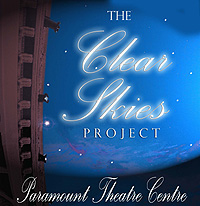![]()
Case Study 2: The Clear Skies Project
How do you make replacing a leaking roof an appealing fund-raiser? You don't make it about the roof.
 |
| View full promotional piece |
The town rallied around the efforts to save the Paramount and the result is nothing less than breathtaking. From the grand ballroom to the theatre itself, the Paramount is a glorious aesthetic delight that excites the senses.
Famed architect John Eberson designed the theatre. It is "atmospheric," which means one has the sense of sitting outside under starlit skies while enjoying the performance on stage. The ceiling—or sky—of the theatre is the most memorable part of any Paramount experience.
"The whole facility is amazing," said Tom Bannon. "But walking into the theatre and seeing that sky is an unforgettable experience. People from the community bring out-of-town family and friends to the facility, and you can really see the excitement in their faces when their guests see the sky for the first time."
However, in 2006, the roof that was replaced in the early 1990's was starting to show wear. Leaks began to emerge, and soon the Paramount sky was showing water damage. The Paramount sky was once again in danger.
The Paramount board knew it had no choice but to get the roof replaced. The cost to replace the roof and fix the related water damage was determined to be $150,000. To make matters more challenging, it wouldn't work to simply shift traditional Paramount fund-raising monies to the roof. The funds donated for the roof project needed to be above and beyond the monies raised each year to fund operations and retire the bank debt.
"Renovating and operating the theatre is a very costly endeavor," said Bannon. "The community supported the project and was rewarded with its efforts, but a project like this is on-going. It is never truly complete. Because of this, you can run the real risk of donor fatigue. However, it had to be done. But it was going to be a major challenge, especially in light of the struggles of the local and national economy."
As chair of the development committee Tom was tasked with developing a plan to raise the needed money. He agreed he would develop some concepts and report back to the board.
"The project was discussed at an executive committee meeting and it was agreed that people like to give money when they can see tangible results," said Bannon. "People won't be able to go up to the roof with their family and friends and say, 'Look, I helped pay for this.' That is why I knew we had to make it about something other than the roof. Making it about protecting the theatre sky seemed obvious and very appealing."
Tom wanted to connect the desire to protect the theatre sky from water damage with the need to protect the whole facility from rainfall. Thus, The Clear Skies Project was born.
"It was a natural name for the project and helped give it focus. I conceived of the concept and wrote the text for the marketing campaign, then Jessica Carson from the Paramount staff brought it to life visually," said Bannon. "Sherri Contos, a Paramount board member and the chair of the marketing and grant committees, then took the ball and ran with it, along with Carson and then Paramount Executive Director Don Volk."
Tom also used his media connections to get the Herald-Bulletin, Anderson's daily newspaper, involved with the project. The Herald-Bulletin ran full-color ads promoting the project, covered the project from a news perspective, and linked to the project from its Website.
"The Herald-Bulletin is community minded and I thought partnering with them would be a win for both organizations," said Bannon. "The exposure from the newspaper campaign, as well as the internal Paramount marketing efforts and the work of the grants committee made this team effort a winner."
Most of the needed costs have been raised and the project is slated to be completed sometime this year.
When the Rotary Club of Anderson, Ind. needed to organize a fund-raiser to fulfill its $15,000 pledge to Rotary International's Polio Plus campaign, Tom Bannon volunteered to chair an event committee.
What do you do when you have a wall that needs to be about seven feet high on one side, but only about five feet high on the other? That was the problem facing Tom Bannon when he worked at Hoosier Park, a pari-mutuel horse racing facility in Anderson, Ind.
Working in a team environment is something Tom Bannon enjoys immensely. In 2004, he got an opportunity to work on a team project for Churchill Downs Incorporated (CDI) that was very challenging and rewarding.
KTJ Marketing
Alternatives Incorporated




